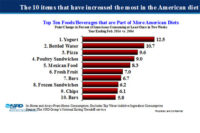What Do Americans Have in Their Kitchens?
Findings by The NPD Group reflect an interest in fresh and more healthful options

More almond milk, Greek yogurt, quinoa, and sea salt are in America’s kitchens today than in 2011, the last time The NPD Group, a leading global information company, conducted its Kitchen Audit survey, which asks U.S. consumers to report on what appliances, cookware, and utensils they own, food ingredients they have on hand, usage, and sources of recipes. Growth in these items and other ingredients suggest a growing interest in fresh and more healthful options, says NPD.

|
From 2003 to 2013, consumption of fresh foods — fruits, vegetables, meat, poultry, fish, and eggs — grew by 20 percent to over 100 billion eatings, reports NPD’s continual tracking of consumers eating behaviors. In the next five years, all three main meal occasions will continue to get even fresher, according to NPD’s recently released The Future of Eating: Who’s Eating What in 2018?, and the youngest generations, Generation Z, ages 0-23, and Millennials, ages 24-37, are driving the trend.
Greek yogurt is an example of a fresh and nutritional food item that is being stocked in more kitchens today than in 2011 when NPD’s Kitchen Audit was last conducted. The household penetration of Greek yogurt rose from 9 percent in 2011 to 29 percent in 2014. Greek yogurt, which is considered a good source of protein, is eaten as is or used in a variety of recipes.
“About half of adults are saying they want more protein in diets and in their quest for more protein, about half of consumers say non-meat sources are best,” says Darren Seifer, NPD food and beverage industry analyst. “Greek yogurt meets the needs of consumers looking for non-meat protein sources.”
Quinoa, an ancient seed that was eaten by the Incas and South Americans for thousands of years has gained new attention in the U.S. as a “super food,” increased its presence in U.S. kitchens by 8 percent since 2011 and is now a staple in 13 percent of households, based on NPD’s most recent Kitchen Audit. Sea salt, which is perceived to be a healthier alternative to table salt, is now on the shelves of 55 percent of homes, a 6 percent increase from 2011. Almond milk, a popular milk substitute considered safe for those who are lactose intolerant or have gluten and casein allergies, increased its household penetration by 6 percent from the 2011 Kitchen Audit, and is now an item in 10 percent of households.
“The fact that U.S. consumers are stocking items that are perceived fresher or healthier speaks to the bigger picture needs of consumers today,” says Seifer. “Not that people are stopping the consumption of other items that historically have been on hand in kitchens, but what people are grabbing for more readily seems to be toward the fresh side with more healthful benefits.”
Looking for a reprint of this article?
From high-res PDFs to custom plaques, order your copy today!





